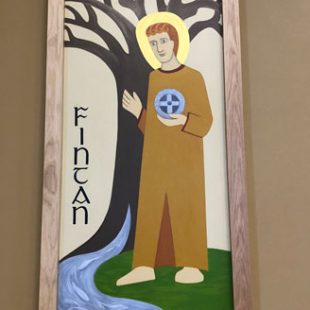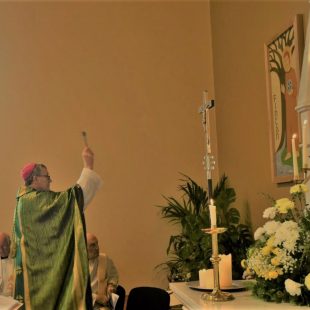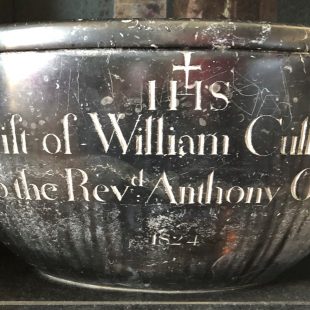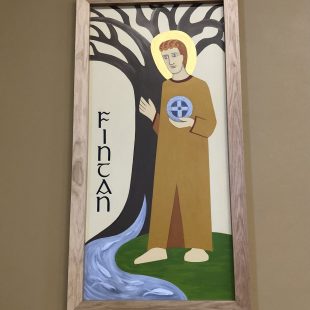Introduction:
We gather in the afternoon of the Sixth Sunday in Ordinary Time to celebrate our Church, our place of worship here in Ballinabranna. I thank Fr. Pat and the team here for the very kind invitation to join you. St. Fintan’s Church has a huge resonance with many generations, the foundation stone was laid in 1823; we will mark the bicentenary in three years time.
But today we celebrate a Church, we celebrate a living faith community, we celebrate he completion of a renovation project, initially started in Fr. Tom’s time and concluded in Fr. Pat’s time, spearheaded by our Deacon Pat Roche, we celebrate a devotion to St. Fintan of Clonenagh, whose feastday is tomorrow and we celebrate a rich ecumenical friendship that led to this site been given over to the building of the church we simply call today ‘Ballinbranna’.
The beautiful image of St. Fintan by local artist Ann Murphy will be blessed now with water coming from the well of St. Fintan, first let us have the Procession of Symbols where amongst the gifts carried up is that water from St. Fintan’s Well at Cromogue, let us bless that water …
Homily:
St. Luke reminds us of the importance of having good solid foundations, when setting out on a building project. There is no mention of #Storm Dennis, but we can be sure these more frequent storms, following closely on #Storm Ciara will test the structure of many of our buildings, not to mention trees that have stood in place as long as Ballinabranna Church and forgotten Election Posters precariously hanging onto polls with loose plastic tyings!
Huge thanks at the outset must be paid to Dr. Shay Kinsella for his excellent short history, especially produced for today’s celebration. Most of what I say this afternoon has been gleaned from Shay’s excellent research and his passion for local history. I also commend Martin Nevin’s research on Ballinbranna. I am not going to give a history lesson, you can read the publications yourselves, just take a couple of points and put them in the context of our story of church and faith today.
A quote from Shay’s introduction beautifully captures the scene for us all: “those builders who laid its first stones on 26 May 1823, had they raised their heads to survey the surrounding countryside, would have seen little beyond the odd thatched cottage, poor mud tracks for roads and small fields of poorly-drained yet fertile land”[1]. Ballinabranna is a very different place today. Raise your heads, look around you. Everything outside has been built around this Church.
Luke’s gospel comes to life in the solid foundations of St. Fintan’s Church, Ballinabranna. Without the Church, originally known as Milford Chapel, we would probably today be at no more than a crossroads. But this is a community, a faith-filled community.
Much is made of the relationship of Bishop JKL and the local landlord John Alexander of Milford House and rightly so. John Alexander was a kind landlord who saw education and practice of faith, important for his Catholic tenants. It was as much about rights as it was about a deep faith. Pope Francis mentions inculturation several times in the four dreams he shares in his recent document speaking to the Amazonian people, entitled ‘Beloved Amazonia’: “I dream of an Amazon region that can preserve its distinctive cultural riches, where the beauty of our humanity shines forth in so many varied ways”[2]. John Alexander appreciated that the cultural identity of Catholics needed acknowledgement and recognition. The site for the chapel would be beside the school-house, a site already given by him. Records suggest there were 45 males and 23 females attending school there in 1824, 62 of them Roman Catholic. A footnote added “scripture not read”[3]. Much is made at the moment of what kind of education system we will have into the future. JKL was a great proponent of rooting faith in the community, not necessarily in the school.
Other Protestant gentry were also generous towards the building of Catholic places of worship, I include Henry Bruen of Oak Park and John Staunton Rochfort, Milford. It wasn’t all plain sailing as our history will tell us. I love Shay Kinsella’s account of how the church pew purchased by local Catholic Pat Neill was singled out for vengeance when he voted for the Tories, against the stated advice of the local PP of the time Fr. Patrick Kehoe (1830-1858). Of course Milford and the limeburners at Clogrennane were the great employers of their day and so often locals were caught between a loyalty to their employer, who was generally good to them and their faith.
Ballinbranna remains a protected structure in Carlow County Council’s records. I am always attracted to the simplicity of this church, no stained glass for instance allows us to appreciate where we are: the God of nature outside and the God we worship inside. Who knows what the future holds for the 117 churches that are part of the eccelesiastical landscape of our diocese? The bulk of those churches are here in the Carlow area. What we clearly can say is that people will always gather here, in appreciation of St. Fintan of Clonenagh. Intriguing it is that as Msgr. Caoimhín O’Neill says in the article at the back of your Mass Booklet: “twelve centuries after the death of St. Gobban (the founder of the great monastery at Old Leighlin), a church within hearing of the bells of Old Leighlin, should be named after the patron saint of the monastery where St. Gobban was buried”. It links this area to the glorious period of early monasticism and their values of hospitality and prayer. We are here gathering to prayer and later in Ballinabranna Clubhouse we will appropriately gather to enjoy hospitality. This is exactly what a living faith community should be. And Ballinabranna epitomises that, something St. Fintan would be very proud of.
[1] Kinsella, Shay: ‘St. Fintan’s Church, Ballinabranna, Co. Carlow – A Short History’, Mochua Print, February 2020, pg. 5
[2] Pope Francis, Querida Amazonia, 2020, ¶7
[3] Brenan, Martin: ‘Schools of Kildare & Leighlin 1775-1835’, Gill & Son, Dublin, 1935, pg. 356
ENDS



